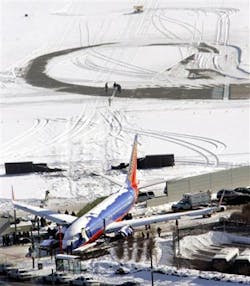Many older airports squeezed next to dense city neighborhoods, bodies of water or steep drop-offs don't have room to allow the 1,000-foot safety margin at the end of the runway that the federal government considers adequate.
Runway overruns can be extremely dangerous. In June 1999, an American Airlines jetliner slid past the end of the runway in Little Rock, Ark., killing nine passengers and injuring 86. And it was only the remarkable speed of the passengers' evacuation - less than two minutes - that prevented serious injury or death when an Air France Airbus skidded off the runway in Toronto and burst into flames in August.
The Federal Aviation Administration in the 1990s began researching a solution to the problem faced by airports that don't have enough space for their runways: putting down a bed of soft concrete to stop or slow an airplane that overruns a runway.
The agency has found that a certain light, crushable concrete will cause an airplane to decelerate. The soft concrete bed, called EMAS, for engineered material arresting systems, extends about 600 feet from the runway's end.
This technology is in place at the end of 18 runways at 14 airports. It has already prevented dangerous overruns three times since May 1999 at John F. Kennedy International Airport in New York, including a Boeing 747 in January, according to the FAA.
There are plans to install EMAS at four more, according to the FAA's Web site.
But a little-noticed provision in the 2006 transportation spending bill signed by President Bush recently will force airports to deal with the problem sooner than they may have planned.
Sen. Frank Lautenberg, D-N.J., sponsored a measure that will require 284 U.S. airports to have at least 1,000 feet at the end of a runway by 2015. That number is based on an FAA inventory of major commercial airports that don't meet the standard.
"It should not take another deadly overrun to convince aviation officials to do something about this problem," Lautenberg said in a statement on Dec. 2.
Lautenberg's concern arose out of several runway overruns in his district: at Teterboro Airport near New York.
In February, a corporate plane carrying 11 people ran off the end of a runway during an aborted takeoff at Teterboro, sped across a busy road and hit a warehouse. Twenty people were injured, including two in a car struck by the plane.
In March, another business plane overshot a runway and stopped in snow and mud. Both passengers and the two crew members walked away uninjured.
It's still unclear whether Thursday night's accident at Chicago's Midway Airport would have been averted by an extra 1,000 feet or a bed of soft concrete.
Safety investigators will look at a number of factors, said Terry McVenes, chairman of the Air Line Pilots Association. "They'll look at the weather, they'll look at the runway conditions, they'll look at the profile of the airplane both on approach and landing," said McVenes, who also heads the association's safety committee.
Peter Goelz, former managing director for the NTSB, said investigators will question whether the airplane should have circled around the airport before attempting a landing.
"You look at the runway, how far down the runway they were, when they came through the overcast, should they have come around?" Goelz asked.
He noted that Southwest Airlines has an excellent safety record, having never had a major crash. But in March 2000, a Southwest Airlines 737 overran a runway at Burbank airport near Los Angeles, stopping within feet of a gas station.
___
On the Net:
Federal Aviation Administration: http://www.faa.gov
News stories provided by third parties are not edited by "Site Publication" staff. For suggestions and comments, please click the Contact link at the bottom of this page.






